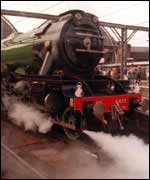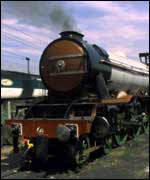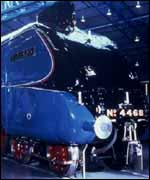|
The Age of Steam
 |
| The Flying Scotsman |
The Flying Scotsman is the only locomotive of its type
left in the world.
But once it was just another steam engine off the busy
production line at the Doncaster works. They built 2,500 of them.
The name 'Flying Scotsman' can sometimes lead to confusion.
Is it a locomotive or is it a train? It is both!
The year 1928 saw the inception of a new non-stop express
passenger service between London Kings Cross and Edinburgh Waverley a
distance of nearly 400 miles.
This new service was called 'The Flying Scotsman'. It
comes as no surprise that locomotive No. 4472 - 'Flying Scotsman' was
chosen to launch the service in May 1928.
The Flying Scotsman
To permit a locomotive to run this long distance without
a stop would require a change of crew whilst on the move.
So Nigel Gresley conceived a tender with a corridor running
down the right hand side. Crews could now change half way between the
two capital Cities, a great innovation.
 |
| The Flying Scotsman gets up steam after a £1m
rebuild |
Ten of these corridor tenders were built for the service
and fitted to the Class A1 and subsequently to the A3's.
The popularity and fame of 'Flying Scotsman' was further
enhanced when in 1934, hauling a dynamometer car; it became the first
steam locomotive to record a fully authenticated speed of 100 miles per
hour.
'Flying Scotsman' continued to give excellent service
for the LNER in its splendid livery of apple green with black, white and
red lining until 1948 when the new nationalised 'British Railways' was
formed.
Apple green was changed first for dark blue and then
dark green and the famous number - 4472 became ultimately 60103.
Doncaster train works
 |
| The Mallard |
The works were much more than a train production plant.
They were a part of Doncaster's social fabric.
By the turn of the century it employed 3000 men working
12 hours a day, six days a week.
They constructed Patrick Stirling's Stirling Single,
Sir Nigel Gresley's Mallard and Henry Ivatt's Ivatt Atlantic.
The locomotive plant provided it's workers with much
more than employment.
St James' Church, which can be seen by anyone passing
through Doncaster on the railway, was built specially for the plant workers.
Workers also had their own sports ground named Eden Grove,
which opened in 1914.
It was the venue for worker's cricket matches, were there
was fierce competition between the workshops.
War years
Life in the workshops changed during World Wars I and
II.
As the men joined up in their hundreds, women took their
place in the works and made ammunition for guns.
Still running
One-hundred-and-fifty years later, 500 people still work
at the plant.
It is nationally important for railway and repair, but
will always be remembered fondly for it's steam traditions.
Many steam engines can still be seen at the National
Rail Museum in York. Details can be obtained from their website.
Doncaster train works fact file
Great Northern Railways brought its engineering
plant to Doncaster in the 1950s.
Patrick Stirling was the plant's first loco-building
Chief Engineer.
The Flying Scotsman was first presented to the
public in 1924.
The Flying Scotsman was the first train in the
world to crash through the 100 mph barrier.
In 1941 the King and Queen toured the Plant to
acknowledge the war work.
Useful Contacts
Yorkshire Film Archive - 01904 716 550.
|

